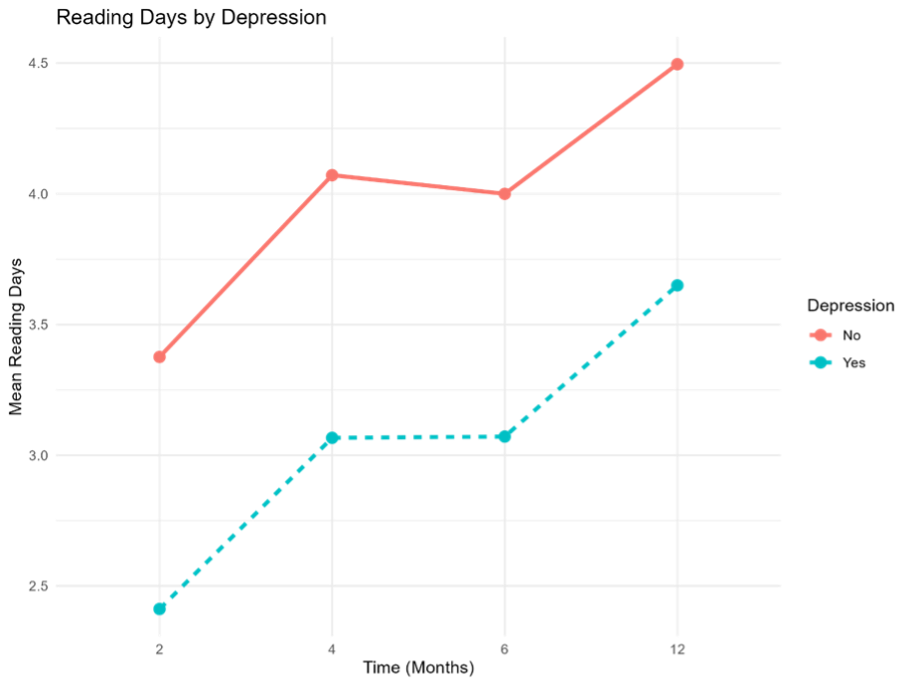Health Equity/Social Determinants of Health 6
Session: Health Equity/Social Determinants of Health 6
726 - Changes in Parental Reading Frequency over the First Year of Life
Sunday, April 27, 2025
8:30am - 10:45am HST
Publication Number: 726.4453
Maureen C. Farrell, North Carolina Children's Hospital, Carrboro, NC, United States; Yumei Yang, University of North Carolina at Chapel Hill Gillings School of Public Health, Chapel Hill, NC, United States; Feng-Chang Lin, UNC Chapel Hill, Chapel Hill, NC, United States; Jennifer McBride, University of North Carolina at Chapel Hill School of Medicine, Chapel Hill, NC, United States; Maria Ansar, Cincinnati Children’s Hospital, Cincinnati, OH, United States; Caitlin P. Green, University of North Carolina at Chapel Hill School of Medicine, Carrboro, NC, United States; Emily Vander Schaaf, University of North Carolina School of Medicine, Carrboro, NC, United States; Kori Flower, University of North Carolina at Chapel Hill School of Medicine, Chapel Hill, NC, United States

Maureen C. Farrell, MD, MS (she/her/hers)
Pediatrics Resident
North Carolina Children's Hospital
Carrboro, North Carolina, United States
Presenting Author(s)
Background: Parent-child shared reading is critical for early relational health. Pediatric clinic-based literacy promotion efforts are uniquely positioned to identify at-risk children and provide resources to improve kindergarten readiness and life-long health outcomes. To guide clinic-based literacy interventions, longitudinal data about infant-parent shared reading behaviors are needed.
Objective: This retrospective analysis aims to characterize the frequency of shared reading over the first year of life. This work will inform primary care-based early literacy promotion interventions.
Design/Methods: A single center retrospective analysis was conducted on infant primary care visits from August 2022 to July 2024. The primary endpoint was frequency of shared reading among infants and caregivers over the first year of life. Reading frequency was reported as days per week of shared reading (range 0-7) collected from the Survey of Well Being of Young Children at 2, 4, 6 and 12 month visits. Clinical data were extracted from the electronic medical record. Associations between reading frequency and clinical and demographic variables were assessed through bivariate analyses. Multivariate models using generalized estimating equations were used to examine change in reading frequency from 2 to 12 months, while accounting for associations with demographic characteristics.
Results: Of 194 infants, 33% were African-American, 25% Caucasian, and 33% Other race; 31% were Hispanic or Latino and 20% primarily spoke Spanish in the home. Sixty-seven percent of patients were insured by Medicaid and 33% of patients had private or military insurance.
In both bivariate and multivariate analyses, shared reading frequency from 2 to 12 months was lower for Medicaid compared with privately insured infants (p=0.011) and for infants whose mothers had depression compared with those that did not (p=0.05) (Figures 1 and 2). After adjustment for maternal depression, insurance status, ethnicity, race, and primary language, shared reading frequency increased from 2 to 12 months, with an increase of 0.11 day per week for each month during this period (p < 0.001).
Conclusion(s): In a diverse population of infants, shared reading frequency increased between 2 and 12 months. Infants who had Medicaid insurance and infants whose mothers had depression had lower shared reading frequency during the first year of life, after adjusting for demographic characteristics. This underscores the importance of literacy promotion efforts for all infants, particularly in the setting of maternal depression and for Medicaid-covered infants.
Maternal depression is associated with lower shared reading frequency from 2 to 12 months of age
 Shared reading frequency (days per week) is plotted over time among infants of mothers with history of depression (light blue) and infants of mothers without history of depression (orange).
Shared reading frequency (days per week) is plotted over time among infants of mothers with history of depression (light blue) and infants of mothers without history of depression (orange). Medicaid insurance is negatively associated with shared reading frequency from 2 to 12 months of age
.png) Shared reading frequency (days per week) is plotted over time according to insurance status. Infants covered by private insurance (light blue) had greater reading frequency at all timepoints compared to infants covered by Medicaid insurance (orange).
Shared reading frequency (days per week) is plotted over time according to insurance status. Infants covered by private insurance (light blue) had greater reading frequency at all timepoints compared to infants covered by Medicaid insurance (orange). A Multivariate Analysis Assessing Associations between Demographic and Clinical Variables and Reading Frequency among Infants
.png) Multivariable results of the overall effect of time, race, ethnicity, language, insurance, and maternal depression on shared reading frequency between caregivers and infants.
Multivariable results of the overall effect of time, race, ethnicity, language, insurance, and maternal depression on shared reading frequency between caregivers and infants. 
